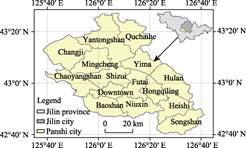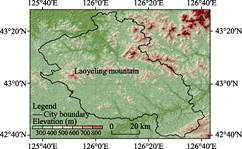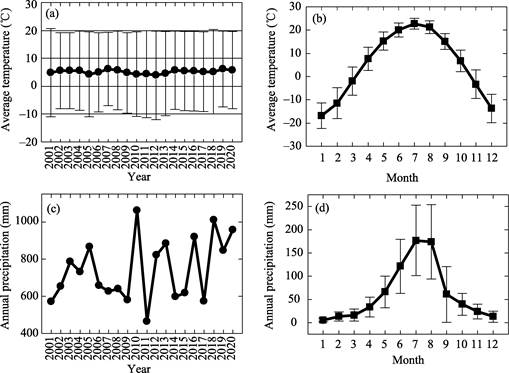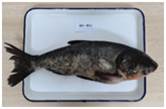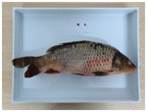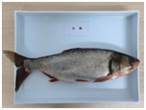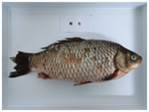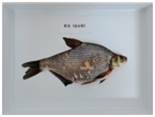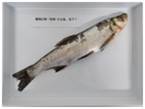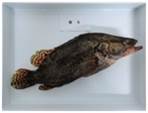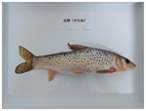Panshi Fishing Qiantang Case in Reservoirs and Fresh Water Bodies
Abstract
Panshi city is located in Jilin city, Jilin province, in the transition zone from Changbai Mountains to Songnen plain, a hilly region and the middle of the second Songhua river basin. The Huifa river and Yinma river are the main water systems; both are major tributaries of the second Songhua river. There are 2,410 reservoirs and ponds which are larger than 248 m2. Heavy metal content of water body and other indicators all meet the national standard of Case I surface water. The water quality is better than the water quality standards of fishery aquaculture. Fishing-hunting culture has a history of more than thousands of years. Panshi city is a representative region with many reservoirs, good water quality and long fishing-hunting culture in China. The case area is characterized by a cool summer and a long ice period in winter. The case study dataset of ecogeographic environmental protection and sustainable development of summer angling and winter fishing in thousands of reservoirs and ponds in Panshi includes location data of case area, the characteristics of reservoirs and pond ecosystems in Huifa river and Yinma river basins, water quality data in 35 reservoirs and fish character data, management data and photos. The main fish stocks are Hypophthalmichthys nobilis, Cyprinus carpio, Megalobrama skolkovii, Hypophthalmichthys molitrix, Siniperca chuatsi, Erythroculter ilishaeformis, Hemibarbus maculatus. The case dataset was stored in .shp, .xlsx, .docx and .jpg formats, with a data size of 33 MB.
Introduction
Panshi is a county-level city in Jilin prefecture, Jilin province of China, which governs 19 town-level units. Spanned between 42°39¢58²N-43°27¢13²N and 125°38¢21²E-126°41¢6²E, Panshi has an area of 3,861 km2 (Figure 1). Panshi is located in the hilly area from Changbai Mountain to Songliao plain, with an altitude range of 230-1,049 m and a relative elevation difference of 819 m (Figure 2). The climate in Panshi is dominated by the monsoon, with mild-rainy summer and long-cold winter[1–3]. Thanks to abundant water, Panshi has a tradition of fishing in summer and winter[4]. Recently, summer and winter fishing as leisure has developed rapidly. The aquatic products yield is about 8400 tons, of which 8,310 tons are fish stocks. To promote the sustainability of Panshi fishery[5,6], we developed this dataset of 35 major reservoirs in Panshi[7].
Metadata of the Dataset
The metadata of the Panshi Qiantang (Thousands Reservoirs) fishing life case dataset of ecosystem protection and sustainable development[7] is summarized in Table 1.
Table 1 Metadata of the dataset[7]
| Items | Description | |
|---|---|---|
| Dataset full name | Panshi Qiantang (Thousands Reservoirs) fishing life case dataset of ecosystem protection and sustainable development | |
| Dataset short name | PanshiFishCase07 | |
| Authors information | Liu, C. L-3684-2016, Institute of Geographic Sciences and Natural Resources Research, Chinese Academy of Sciences (IGSNRR/CAS), liuchuang@igsnrr.ac.cn Guo, X. Y. 0000-0002-8651-615X, Key Laboratory of Geographical Processes and Ecological Security in Changbai Mountains, Ministry of Education, School of Geographical Sciences, Northeast Normal University, guoxy914@nenu.edu.cn, orcid: Liu, Y. H., Fisheries Research Institute of Jilin Province, liuyanhui9@163.com Liu, T. G., Fisheries Research Institute of Jilin Province, ltg0322@163.com Qi, W., Panshi City People’s Government, 931300049@qq.com Wang Zhengwen, Panshi City Agriculture and Rural Affairs Bureau, 1104335154@qq.com Qiao, Y. B., Panshi City Agriculture and Rural Affairs Bureau, pssnyj@163.com Wu, F., Panshi Supply and Marketing Investment Group Co., Ltd., 1055318092@qq.com Chen, C. H., Panshi City Agriculture and Rural Affairs Bureau, 294576808@qq.com Fu Jingying, IGSNRR/CAS, fujy@igsnrr.ac.cn Zhu, X. G., Beijing Tian Hang Hua Chuang Technology Co., Ltd., 18510867688@163.com | |
| Geographical area | 2410 reservoirs and ponds in Panshi city, Jilin city, Jilin province (minimum area 248 m2) | |
| Year | 2001–2021 | |
| Data format | .shp, .xlsx, .docx, .jpg | |
| Data size | 33 MB | |
| Data files | 1_BND_StudyArea, 2_PhysicalGeoData, 3_CharacteristicsSpecies, 4_ManagementData, 5_Photos | |
| Fundation | Cooperation Project between Chinese Academy of Sciences Local institutions | |
| Data publisher | Global Change Research Data Publishing & Repository, http://www.geodoi.ac.cn | |
| Address | No. 11A, Datun Road, Chaoyang District, Beijing 100101, China | |
| Data sharing policy | The data of the global change scientific research data publishing system include metadata (Chinese and English), entity data (Chinese and English) and data papers (Chinese and English) published through the Journal of Global Change Data. The sharing policies are as follows: (1) “Data” are free to the whole society through the internet system in the most convenient way, and users can browse and download it for free; (2) the end-user needs to indicate the data source in the reference or appropriate position according to the reference format when using “data”; (3) users of value-added services or users who distribute and disseminate “data” in any form (including through computer servers) need to sign a written agreement with the editorial department of Journal of Global Change Data (Chinese and English) and obtain permission; (4) the author who extracts some records from the “data” to create new data should follow the 10% citation principle; that is, the data records extracted from this data set are less than 10% of the total records of the new data set, and the data source of the extracted data records should be indicated[8] | |
| Communication and searchable system | DOI, CSTR, Crossref, DCI, CSCD, CNKI, SciEngine, WDS/ISC, GEOSS |
DOI: https://doi.org/10.3974/geodp.2021.04.03
CSTR: https://cstr.escience.org.cn/CSTR: 20146.14.2021.04.03
Dataset Availability Statement:
The dataset supporting this paper was published and is accessible through the Digital Journal of Global Change Data Repository at https://doi.org/10.3974/geodb.2021.12.42.V1 or https://cstr.escience.org.cn/CSTR:20146.11.2021.12.42.V1
Physical Geography of Panshi City
Climate
Panshi is located in the middle temperate and humid zone, with a continental monsoon climate[1-3]. According to the annual average meteorological data from 2001 to 2020, the annual average temperature of Panshi is 5.2 °C, ranging from ‒ 16.9 °C (January) to 22.7 °C (July). The annual precipitation is 743 mm, 60% of which from June to August (Figure 3). Moderate rainfall and comfortable temperature in summer make it suitable for leisure fishing. In winter, the freezing period on the water bodies exceeds 20 days, so it is good for winter fishing activities.
Hydrological Characteristics and Watershed Division
Two major rivers—Huifa river and Yinma river are through the Panshi city. With the Hada Ridge as the divide crest, both rivers are the primary tributaries of the second Songhua river[9]. The Huifa river flows in the south of Panshi. It originates from Liaoning Province and flows from west to East. The length of its reach in Panshi is 51.46 km, with a drainage area of 2,291 km2, accounting for 60% of the total area of Panshi city. In Panshi, 39 rivers flow into Huifa river, including 10 primary tributaries, 21 secondary tributaries and 8 tertiary tributaries [4]. On the other hand, Yinma river flows in the north of Panshi. Its reach in Panshi is 72.7 km, with a drainage area of 1,267 km2. There are 12 primary and 12 secondary tributaries flowing into Yinma river[4]. The northeast part of Panshi belongs to Chalu river, which originates from Hadaling Mountains. It is an important tributary of Yinma river, with a drainage area of 257 km2. Another small part in the east Panshi belongs to Badaohe river, and finally flows into Huifa river in Huadian city (Figure 4).
| Figure 4 Map of hydrological system and water bodies in Panshi city | Figure 5 Map of water sampling sites in Panshi city |
|---|---|
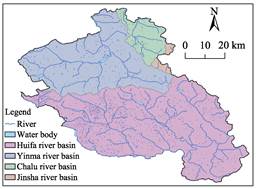 |
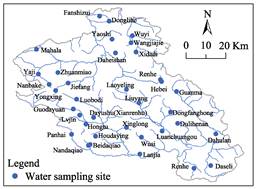 |
Water Resources and Water Quality
Panshi city is rich in water resources, of which 2,410 reservoirs and ponds are larger than 248 M2 (Figure 4). Panshi has abundant water resources, and the average surface water runoff is 8.05×108 m3, the groundwater resource is 2.02×108 m3, and the annual average inflow is 1.83×109 m3[9]。Panshi has 4 medium-sized reservoirs (Huanghe R., Yaji R., Liuyang R. and Guanma R.), which are suitable for fish culture[4]; There are 23 Small-I and 133 Small-II reservoirs respectively[10]. In 2020, Panshi was designated by the Ministry of Water Resources as the first batch of model counties to deepen the reform of small reservoir management.
According to the Fishery Zoning of Jilin Province, Panshi belongs to the hilly reservoir pond aquaculture area in the middle east of Jilin province: the water is rich in nutrients and plankton, and the water level is appropriate. Fish can survive the winter safely, and a fish culture base based on reservoir fishery can be built[12]. Panshi water system originates from Changbai Mountain, which is the distribution area of natural mineral waters[13]. In order to further understanding the safety of water bodies to fisheries, the author collected water samples from 35 main reservoirs and ponds (Table 2 and Figure 5)[14-48], and the quality of water samples was tested by Jilin Huake Testing Co., Ltd. and the Physical and Chemical Analysis Center of the Institute of Geographic Sciences and Natural Resources Research, Chinese Academy of Sciences (Table 3).
Compared with the National fishery water quality standard (GB 11607—89) and the Environmental quality standard for surface water (GB 3838—83), all the water quality indicators of the collected water samples meet the standards and the 8 elements such as, Cd, and Cr all meet the standards of Class I Surface Water (equivalent to that of the source water and the National Nature Reserve).
Table 2 Names and locations of water sampling sites in the case study area
| No. | Name | Town | No. | Name | Town |
|---|---|---|---|---|---|
| 1 | Guanma reservoir | Hulan town | 19 | Lvjin reservoir | Changyangshan town |
| 2 | Xinglong reservoir | Niuxin town | 20 | Laoyeling reservoir | Shizui town |
| 3 | Wusi reservoir | Niuxin town | 21 | Luobodi reservoir | Shizui town |
| 4 | Lanjia reservoir | Niuxin town | 22 | Daseli reservoir | Songshan town |
| 5 | Luanchuangou reseroir | Niuxin town | 23 | Renhe reservoir | Songshan town |
| 6 | Donglihe reservoir | Yantongshan town | 24 | Dulihenan reservoir | Hongqiling town |
| 7 | Fanshizui reservoir | Yantongshan town | 25 | Dongfanghong reservoir | Hongqiling town |
| 8 | Daheishan reservoir | Yantongshan town | 26 | Hongtu reservoir | Fuan subdistrict |
| 9 | Yaoshi reservoir | Yantongshan town | 27 | Jiefang reservoir | Mingcheng town |
| 10 | Panhai reservoir | Baoshan village | 28 | Yongxing reservoir | Mingcheng town |
| 11 | Houdaying ponds | Baoshan village | 29 | Hebei reservoir | Yima town |
| 12 | Beidaqiao ponds | Baoshan village | 30 | Renhe reservoir | Yima town |
| 13 | Nandaqiao ponds | Baoshan village | 31 | Wangjiajie reservoir | Qucaihe town |
| 14 | Liuyang reservoir | Futai town | 32 | Wuyi reservoir | Qucaihe town |
| 15 | Malaha reservoir | Jichang town | 33 | Xidadi reservoir | Qucaihe town |
| 16 | Nanbake reservoir | Jichang town | 34 | Dahulan reservoir | Heshi town |
| 17 | Yaji reservoir | Jichang town | 35 | Xianrenhu reservoir | Panshi development zone |
| 18 | Zhuanmiao reservoir | Jichang town |
Table 3 Water quality of sample in the case study area (e.g., Guanma reservoir)
| Indicator | Value | Indicator | Value | Indicator | Value |
|---|---|---|---|---|---|
| As | 0 | Zn | 0 | Ammonia Nitrogen (mg/L) | 0.378 |
| Cd | 0 | Hg | 0.000,04% | BHC (mg/L) | 0.000,004 |
| Cr | 0 | Chromaticity (degree) | 10 | DDT (mg/L) | 0.000,2 |
| Cu | 0.000,2% | Smell and taste | Without any smell | Nitrite Nitrogen (mg/L) | 0.004,9 |
| Ni | 0.000,3% | Permanganate Index (mg/L) | 4.2 | Total Phosphorus (mg/L) | 0.08 |
| Pb | 0 | Total Coliform Bacteria (MPN/L) | <20 | pH | 7.2 |
Species/Varieties and Quality of Fish Stocks
Species/Varieties of Fish Stocks
There are over 30 kinds of common fish in Panshi city: Aristichthysnobilis (Figure 6), Cyprinuscarpio (Figure 7), Hypophthalmichthys molitrix (Figure 8), Carassiusauratus (Figure 9), Megalobramaamblycephala (Figure10), Erythroculterilishaeformis (Figure11), Siniperca chuatsi (Figure12), Hemibarbus maculatus (Figure 13), etc[4] [1].
Aristichthys nobilis, family Cyprinidae, genus Aristichthys, also known as bighead carp, is commonly known as fat head (Figure 6). Aristichthys nobilis is a common fish species in Panshi city, one of the four famous Chinese carp, and is a typical filter-feeding fish. It is warm-water fish, living in the upper middle layer of the reservoir. As a typical of zooplankton-feeding fish, from fry to adults, it feeds mainly on zooplankton and also on phytoplankton and organic matter in the water column.
Cyprinus carpio, family Cyprinidae, genus Cyprinus (Figure 7), is a typical omnivore. It is strongly adaptable to the living environment, inhabiting the bottom of the water, with a mild and vigorous temperament, resistant to both cold and hypoxia deprivation. Young Cyprinus carpio mainly feeds on rotifers, crustaceans and small invertebrates. It is mixed with Ctenopharyngodon idellus, Megalobrama amblycephala, Carassius auratus and Hypophthalmichthys molitrix.
Hypophthalmichthys molitrix, family Cyprinidae, genus Hypophthalmichthys (Figure 8), is a typical filter-feeding fish. In the upper layers of the water, it feeds on diatoms, green algae and other phytoplankton. Mixed with Megalobrama amblycephala, Cyprinus carpio, Ctenopharyngodon idellus, Carassius auratus and so on.
Carassius auratus, family Cyprinidae, genus Carassius (Figure 9), is a typical omnivore. The life level belongs to the bottom fish, mainly omnivorous fish that feeds on plants. In general, it swims, forages and inhabits underwater.
Megalobrama amblycephala, is a genus of Megalobrama in the family Cyprinidae, also known as Wuchang fish (Figure 10). It is herbivorous freshwater fish with a body length of 165-456mm, flat and high on the side, rhombic in shape, with a thick back and a wide and short tail stalk. The body is bluish gray, the base of the body sides scale is light color and the two sides are grayish black, forming several rows of longitudinal lines of intersecting depth on the body. The fins are grayish black. It is more suitable for hydrostatic life. Normally inhabits in the middle and lower layers of open water areas where the sediment is silt and submerged plants are growing. In winter, they prefer to overwinter in deep water.
Erythroculter ilishaeformis, family Cyprinidae, genus Culter (Figure 11), is a ferocious carnivorous fish that feeds on cladocerae, copepods and aquatic insects as juvenile fish, shrimp, snails, insects, larvae and cladocerae as adults.
Siniperca chuatsi, family Serranidae, genus Siniperca (Figure 12), is a carnivorous freshwater fish. The most prominent biological characteristic of Siniperca chuatsi is its ferocious carnivorous nature and its ability to discriminate between baits. It mainly feeds on live fish and shrimp throughout its life, and even newly opened fry feed on the fry of other fish. After growing up, in addition to eating live fish, but also eat shrimp and tadpoles and so on. It lives in the lower and middle waters of the muddy reservoirs, ponds and dams where Unionidae lives.
Hemibarbus maculatus, family Cyprinidae, genus Hemibarbus, commonly known as Jigou Fish (Figure 13), belongs to bottom fish, preferring the lower and middle layers of water, feeding on benthic animals, mainly aquatic mollusks, and also eating a variety of small fish. It's an omnivorous fish with a carnivorous bias.
In addition to fish, there are other aquatic organisms in the waters of Panshi city, including otter, muskrat, turtle, mussel (Figure 14), forest frog, frog, river shrimp, field snail, ear snail and cloth snail; Aquatic plants include reed, cattail and water chestnut [4].
Aquatic Habitat Types
In this case, 35 reservoirs and ponds are selected. The water depth of most of the water bodies is between 0.8-6 m, and the deepest reservoir can reach to 12 m. The water bodies are divided into two types: sand-bottom and mud-bottom.
Sand-bottom reservoirs (ponds): Panhai, Lvjin, Daseli, Dongfanghong, and Hebei (5).
Mud-bottom reservoirs (ponds): Houdaying, Beidaqiao, Nandaqiao, Xinglong, Wusi, Lanjia, Lanchuangou, Donglihe, Fanshizui, Daheishi, Yaoshi, Liuyang, Mahala, Nanbake, Yaji, Zhuanmiao, Laoyeling, Luosudi, Renhe, Dulihan, Hongtu, Jiefang Yongxing, Renhe, Guanma, Wangjiajie, Wuyi, Sidi, Dahulan, Xianrenhu (30).
Quality Inspection of Fish Products
We caught fish samples at the end of autumn of 2021 and tested the characteristics of samples. The testing items included pesticide residues, prohibited drug residues, heavy metals and nutrient ingredients. The testing was implemented by professional institute with CMA license. According to the testing reports (Table 4), all fish samples were free of pesticide and prohibited drug residues. The upper limits of Hg, Pb, Cd and Cr are 0.5, 0.1, 0.5 and 2 mg/kg in the Standard for food safety, respectively. As shown in Table 4, the heavy metal contents of all fish e from the case area were lower than limit values of the standard.
The nutrient result showed that the protein content of the fish in wet weight was 17.7%-23.6%, fat content was 0.7%-3.2%, and moisture content was less than 80%. The composition proportion of essential amino acids and umami amino acids were close to 40% which is ideal protein requirement, and the amino acid index was above 85 score. Fatty acid content was tested for Aristichthys nobilis and Cyprinus carpio because they had considerable bodies. The results showed that fatty acid content was 0.59% and 1.73% for both fishes, which could improve the utilization rate of protein in food. For these reasons, the fishes from the case area have high protein, low fat, low moisture content, delicious meat, rich nutrition and balanced proportion, and high ash content (4.5%-6%) (essential minerals and trace elements). The unsaturated fatty acid (EPA+DHA) content is 2.24% and 3.94% for Cyprinus carpio and Aristichthys nobilis, respectively. Quality of fishes from reservoirs of Panshi performs better than that from reservoirs of other ponds.
Table 4 Fish quality data
| Indicator | Fish Species | ||||||||
|---|---|---|---|---|---|---|---|---|---|
| Aristichthys-nobilis | Cyprinus- carpio | Hypophthal-michthys molitrix | Carassius- auratus | Megalobra-maamblycephala | Siniperca chuatsi | Erythrocl- terillishaeformis | Hemibarbus maculatus | ||
| Pesticide residues | HCH (μg/kg) | 0 | 0 | 0 | 0 | 0 | 0 | 0 | 0 |
| DDT (μg/kg) | 0 | 0 | 0 | 0 | 0 | 0 | 0 | 0 | |
| Prohibited drug residue | MG (μg/kg) | 0 | 0 | 0 | 0 | 0 | 0 | 0 | 0 |
| AOZ (μg/kg) | 0 | 0 | 0 | 0 | 0 | 0 | 0 | 0 | |
| SEM (μg/kg) | 0 | 0 | 0 | 0 | 0 | 0 | 0 | 0 | |
| AMOZ (μg/kg) | 0 | 0 | 0 | 0 | 0 | 0 | 0 | 0 | |
| AHD (μg/kg) | 0 | 0 | 0 | 0 | 0 | 0 | 0 | 0 | |
| Heavy metal residue | Hg (mg/kg) | 0 | 0 | 0 | 0 | 0 | 0 | 0.018 | 0 |
| Cd (mg/kg) | 0 | 0.007 | 0 | 0 | 0 | 0 | 0 | 0 | |
| Cr (mg/kg) | 0.07 | 0.004 | 0.12 | 0.06 | 0.16 | 0.21 | 0.47 | 0.08 | |
| Nutritional ingredient | Protein (g/100g) | 17.7 | 23 | 19.5 | 18.8 | 23.6 | 22.2 | 21.1 | 20.6 |
| Fat (g/100g) | 2.2 | 0.7 | 1 | 3.2 | 1.6 | 2.2 | 1 | 1 | |
| Moisture (g/100g) | 77.8 | 74.9 | 75.9 | 71.4 | 78.6 | 71.1 | 73.6 | 78.1 | |
| Ash (g/100g) | 4.2 | 5.5 | 4.8 | 4.2 | 3.9 | 4.4 | 4.3 | 4.3 | |
| WTAA (g/100g) | 16.2 | 12.9 | 13.5 | 11.5 | 13.3 | 11.4 | 12 | 12.2 | |
| WEAA (g/100g) | 5.8 | 4.4 | 4.3 | 3.5 | 4.2 | 3.8 | 4 | 4 | |
| TFA (g/100g) | 2.24 | 3.94 | |||||||
| SFA (g/100g) | 1.16 | 1.97 | |||||||
| MUFA (g/100g) | 0.05 | 0.25 | |||||||
| PUFA (g/100g) | 0.59 | 1.73 |
Management Data
General Management
There are 1,425 fishery households composed of 5,625 people, including 2,367 fishery employees in Panshi city. In recent years, 80 professionals and over 200 inspectors have been staffed to undertake daily maintenance of the water systems. Since 2019, the annual budget for water conservancy has been 2.57 million Yuan in Panshi, and the yearly revenue of fishery in Panshi is 168.93 million Yuan. Panshi provides fishermen with aquatic skill services in a variety of ways: establishing demonstration households, holding training courses, on site observation, etc. In addition, Panshi also values aquatic animal epidemic prevention monitoring and aquatic seedling origin quarantine to ensure the fishery safety.
Product Marketing
The products of the case study are sold by Panshi Supply and Marketing Investment Group Co., Ltd., which was registered at Panshi Economic Development Zone on June 11, 2021. The main shareholders of the company include Panshi Supply and Marketing Cooperative Federation, Panshi Beiyou Rural Comprehensive Service Professional Cooperation Association, Panshi Huinong Accounting Service Co., Ltd., and Panshi Jigao Vocational Skills Training School. The major task of Panshi Supply and Marketing Investment Group Co., Ltd. is to increase farmers’ (including fishermen’s) income by improving the organizational level of farmers and agricultural restructuring.
Trademark
A trademark was registered in December, 2021: “Panshi Qiangtang (Thousands Reservoir) Fish” (Figure 15).
Establishment of Ecological Monitoring System
In order to monitoring environment of reservoirs and ponds, 12 monitoring stations were fixed for medium and long-term monitoring, including 10 ecological stations (Figure 16), 1 water quality station, and 1 video station. Monitoring items are real-time visible landscape photos, meteorological elements, automatic identification and recording of water quality.
The Tradition of Winter Fishing in the Second Songhua River
In the late Paleolithic period (40,000 to 70,000 years ago), the Northeast ancestors living by the second Songhua river began to use primitive tools to fish and shrimp. In the Neolithic Age (4,000 years ago), the Sushen (Panshi was part of Sushen in the Xia, Shang, Zhou and Qin Dynasties) tribe along the Songhua river began to use bone fish bladder, harpoon, hook and other fishing tools, evidenced by the Neolithic sites in the basin. During the Bohai State Period (698-926 A.D.), some fishing life in the Northeast became tribute to the Tang dynasty. In the Liao and Jin Dynasties, fishing was one of the popular activities of princes and nobles. In winter, the water surface in Northeast China is generally frozen, which promotes the development of fishing activities in winter. The Khitans began winter fishing very early. They dug small holes in the ice and hooked fish with bait. King Khitan and his princes and ministers also chiseled ice on the ice of the second Songhua river to get fish. During the reign of Emperor Kangxi of the Qing dynasty, immigrants from Shandong invented the “Liangzi” fishing method: wicker is woven into a network to block the outlet of the stream, allowing the water to pass through but keeping the fish behind the network. Fish can be caught when the water level drops after freezing. In addition, people can catch fish with nets in winter. The improvement of fishing technique has promoted winter fishing. In addition, the ice surface in winter is easy to pass, and the fish products are easy to be preserved, which has promoted the development of winter fishing in the upper reaches of the second Songhua river[50].
The fishing culture in the Songhua river basin reached its heyday in the Qing dynasty. In the early Qing dynasty, Jilin’s fishery was regional and exclusive. In 1657, the Qing government set up a special organization in Jilin to catch rare fish and offer them to the royal family as a tribute. In the middle of the Qing dynasty, with a large number of immigrants moving to Jilin, the folk fishing increased day by day, resulting in fishing households all year round. In the late Qing dynasty, as the exclusive fishery in Northeast China was gradually transformed into an ordinary livelihood, the fishery resources were more widely developed, which laid the foundation for the fishery in Jilin today[50]. According to incomplete statistics in 1908, there were 494 professional fishermen and 171 fishing boats in Jilin province, with an annual fish output of 931,077 kg[51]. A record in 1913 reported that Panshi and Huadian counties in Huifa river basin had an annual output of more than 6,000 kg of fish. With the continuous progress of modern fishery model, more fishery companies began to be established in the basin[52].
In the early 1950s, Panshi began to use various natural water bodies (small reservoirs and ponds) to develop fisheries and tried to raise fish in rice fields[12]. In the late 1950s, Jilin province began to study the artificial reproduction techniques of silver carp, bighead carp, carp and other fish, and achieved success in 1966[53]. In 1968, Yima town of Panshi raised 420,000 fish fry in a small reservoir and benefited fairly[12].
To further nurture fishing culture in Panshi, in December 2021, Institute of Geographic Sciences and Natural Resources Research of the Chinese Academy of Sciences, Chinese Geographical Society, and Global Change Research Data Publishing & Repository, jointly reviewed the GIES case dataset on summer angling and winter fishing in Thousands of Reservoirs and Ponds in Panshi, and awarded it a high-quality case. Prof. Ge, Q. S., General Director of the Institute of Geographic Sciences and Natural Resources Research, CAS, inscribed “Panshi Qiangtang (Thousands Reservoir) Fish” (Figure 17). The Panshi government also initiates to continuously promote the “Panshi winter fishing Cultural Festival”. All these measures are expected to uplift the inheritance and development of Panshi fishing and hunting culture to a new level.
| Figure 16 Map of the monitoring sites geo-location | Figure 17 “Panshi Qiantang (Thousands Reservoir) Fish” inscribed by Prof. Ge, Q. S. |
|---|---|
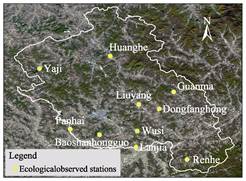 |
 |
Discussion and Conclusion
Just as its name implies, “Panshi Qiangtang (Thousands Reservoir) Fish” is fish products from thousands of water bodies in Panshi, its unique natural endowments and long history of fishing have been two factors for the present achievements. However, in the context of the national strategy for “Rural Modernization”, more efforts need to be made to protect environment and develop the economy. While Panshi “Thousands Reservoir Fish” has made phased progress in brand lift, management and ecological monitoring, there is still much room for improvement.
Management Standardization
At present, there are already some national standards for aquaculture, yet more detailed and specific standards closely related to the daily management of Panshi fish are still absent, such as water quality inspection standards, stocking standards for different fish species, fishing standards, fishing management specifications, classification standards for fresh and living fish (freshness of fish products), and control standards for aquatic plants in reservoirs of different sizes, the standard of combining intensive and coarse cultivation in medium-sized reservoirs, and the standard for feeding and fertilization in small-sized waters.
Keeping the Fishing Environment
At present, Panshi fish mainly grow under natural conditions. With the increase of market demand, it is more important that to keep the fish environment and ecosystem health and sustainability. The water size of reservoir has a great impact on fishery management. In reservoirs with a water area of over 3.33ha, filter-feeding and herbivorous fish can be raised, which can reduce algae and aquatic plants and purify the water body. We also need to further study the technique of raising silver carp and bighead carp in large reservoir, explore the mechanism of fish-water-aquatic ecosystem balance, and find an effective way to convert the eutrophic substances in the reservoir into high-quality fish protein through fish culture.
Combination of Fishing Culture and Ecotourism
The fishing-hunting of summer angling and winter fishing in Panshi dates back to thousands of years, which has become popular in the Qing dynasty and becomes even more welcome recently. In the future, the integration of fishing and hunting culture, eco-tourism, and ice and snow culture in Panshi city will contribute more to the regional sustainable development.
References
[1] Fu, J. Y., Du, X. L, Zheng, Q. S., et al. GIES case dataset on rice permanent farmland in Lanjia village, Jilin province of China [J]. Journal of Global Change Data & Discovery, 2021, 5(3): 275–289. https://doi.org/10.3974/ geodp.2021.03.06.
[2] Pang, X. L., Li, B. Y. Comprehensive analysis of climate characteristics of Panshi city in 2017 [J]. Modern Agricultural Science and Technology, 2018(22): 223–226.
[3] Li, C., Zhang, Y. Main types of agrometeorological disasters and effective preventive measures in Panshi city [J]. Journal of Heilongjiang Grain, 2021(7): 109–110.
[4] Panshi City Chronicles Compilation Committee. Panshi City Annals (1991-2003) [M]. Changchun: Jilin Literature and History Publishing House, 2006.
[5] Department of Agriculture and Rural Affairs of Jilin Province, Department of Ecology and Environment of Jilin Province, Department of Water Resources of Jilin Province, et al. Development planning of large water surface ecological fisheries in Jilin province (2020-2025) [R]. 2020.
[6] Liu, C., Gong, K., Liu, Y. H., et al. An innovative solution on geographical indications for environment & sustainability (GIES) [J]. Journal of Global Change Data & Discovery, 2021, 5(3): 237–248. https://doi.org/ 10.3974/geodp.2021.03.03. https://doi.org/10.3974/geodp.2021.03.03.
[7] Liu, C., Guo, X. Y., Liu, Y. H., et al. GIES case dataset on summer angling and winter fishing in thousands of reservoirs and ponds in Panshi, Jilin province of China [J/DB/OL]. Digital Journal of Global Change Data Repository, 2021. https://doi.org/10.3974/geodb.2021.12.42.V1. https://cstr.escience.org.cn/CSTR:20146.11.2021.12.42.V1.
[8] GCdataPR Editorial Office. GCdataPR data sharing policy [OL]. https://doi.org/10.3974/dp.policy.2014.05 (Updated 2017).
[9] Zhang, J. J. Study on water resources allocation in small and medium-sized watersheds: the case of Panshi city [D]. Beijing: China Institute of Water Resources and Hydropower Research, 2018.
[10] Zhang, J. J., Han, X. J. The urgent problems in water resources management in Panshi city [J]. Jilin Water Resources, 2016(12): 38–39, 47.
[11] Jilin Provincial Water Resources Department, Operation Management and Reservoir Migration Division. Reservoir reinforcement and operation management Jilin Panshi: deepen the small reservoir management system reform demonstration counties to create a comprehensive improvement of small reservoir management [J]. Jilin Water Resources, 2021(10): 2.
[12] Jilin Province Chronicles Compilation Committee. Jilin Provincial Annals [M]. Changchun: Jilin people’s Publishing House, 1996.
[13] Dong, Y. Research on the relationship between natural mineral water and surface water in the basalt area of Changbai mountain [D]. Changchun: Jilin University, 2020.
[14] Guo, X. Y., Yang, Y. H., Fu, J. Y., et al. Guanma reservoir, winter fish-catching place in Panshi, Jilin province of China [J/DB/OL]. Digital Journal of Global Change Data Repository, 2021. https://doi.org/10.3974/geodb. 2021.12.16.V1. https://cstr.escience.org.cn/CSTR:20146.11.2021.12.16.V1.
[15] Guo, X. Y., Liu, H. Q., Fu, J. Y., et al. Xinglong reservoir, winter fish-catching place in Panshi, Jilin province of China [J/DB/OL]. Digital Journal of Global Change Data Repository, 2021. https://doi.org/10.3974/geodb. 2021.12.26.V1. https://cstr.escience.org.cn/CSTR:20146.11.2021.12.26.V1.
[16] Guo, X. Y., Liu, H. Q., Fu, J. Y., et al. Wusi reservoir, winter fish-catching place in Panshi, Jilin province of China [J/DB/OL]. Digital Journal of Global Change Data Repository, 2021. https://doi.org/10.3974/geodb. 2021.12.07.V1. https://cstr.escience.org.cn/CSTR:20146.11.2021.12.07.V1.
[17] Fu, J. Y., Liu, H. Q., Guo, X. Y., et al. Lanjia reservoir, winter fish-catching place in Panshi, Jilin province of China [J/DB/OL]. Digital Journal of Global Change Data Repository, 2021. https://doi.org/10.3974/geodb. 2021.12.06.V1. https://cstr.escience.org.cn/CSTR:20146.11.2021.12.06.V1.
[18] Guo, X. Y., Liu, H. Q., Fu, J. Y., et al. Luanchuangou reservoir, winter fish-catching place in Panshi, Jilin province of China [J/DB/OL]. Digital Journal of Global Change Data Repository, 2021. https://doi.org/10.3974/ geodb.2021.12.31.V1. https://cstr.escience.org.cn/CSTR:20146.11.2021.12.31.V1.
[19] Guo, X. Y., Huang, F. J., Fu, J. Y., et al. Donglihe reservoir, winter fish-catching place in Panshi, Jilin province of China [J/DB/OL]. Digital Journal of Global Change Data Repository, 2021. https://doi.org/10.3974/geodb. 2021.12.15.V1. https://cstr.escience.org.cn/CSTR:20146.11.2021.12.15.V1.
[20] Guo, X. Y., Huang, F. J., Fu, J. Y., et al. Fanshizui reservoir, winter fish-catching place in Panshi, Jilin province of China [J/DB/OL]. Digital Journal of Global Change Data Repository, 2021. https://doi.org/10.3974/geodb. 2021.12.14.V1. https://cstr.escience.org.cn/CSTR:20146.11.2021.12.14.V1.
[21] Guo, X. Y., Huang, F. J., Fu, J. Y., et al. Daheishan reservoir, winter fish-catching place in Panshi, Jilin province of China [J/DB/OL]. Digital Journal of Global Change Data Repository, 2021. https://doi.org/10.3974/ geodb.2021.12.32.V1. https://cstr.escience.org.cn/CSTR:20146.11.2021.12.32.V1.
[22] Guo, X. Y., Huang, F. J., Fu, J. Y., et al. Yaoshi reservoir, winter fish-catching place in Panshi, Jilin province of China [J/DB/OL]. Digital Journal of Global Change Data Repository, 2021. https://doi.org/10.3974/geodb. 2021.12.40.V1. https://cstr.escience.org.cn/CSTR:20146.11.2021.12.40.V1.
[23] Guo, X. Y., Song, J., Fu, J. Y., et al. Panhai Reservoir, Winter Fish-catching Place in Panshi, Jilin province of China [J/DB/OL]. Digital Journal of Global Change Data Repository, 2021. https://doi.org/10.3974/geodb. 2021.12.08.V1. https://cstr.escience.org.cn/CSTR:20146.11.2021.12.08.V1.
[24] Guo, X. Y., Song, J., Fu, J. Y., et al. Houdaying reservoir, winter fish-catching place in Panshi, Jilin province of China [J/DB/OL]. Digital Journal of Global Change Data Repository, 2021. https://doi.org/10.3974/geodb. 2021.12.09.V1. https://cstr.escience.org.cn/CSTR:20146.11.2021.12.09.V1.
[25] Guo, X. Y., Song, J., Fu, J. Y., et al. Beidaqiao reservoir, winter fish-catching place in Panshi, Jilin province of China [J/DB/OL]. Digital Journal of Global Change Data Repository, 2021. https://doi.org/10.3974/geodb. 2021.12.24.V1. https://cstr.escience.org.cn/CSTR:20146.11.2021.12.24.V1.
[26] Guo, X. Y., Song, J., Fu, J. Y., et al. Nandaqiao reservoir, winter fish-catching place in Panshi, Jilin province of China [J/DB/OL]. Digital Journal of Global Change Data Repository, 2021. https://doi.org/10.3974/geodb. 2021.12.37.V1. https://cstr.escience.org.cn/CSTR:20146.11.2021.12.37.V1.
[27] Guo, X. Y., Mu, C., Fu, J. Y., et al. Liuyang reservoir, winter fish-catching place in Panshi, Jilin province of China [J/DB/OL]. Digital Journal of Global Change Data Repository, 2021. https://doi.org/10.3974/geodb. 2021.12.39.V1. https://cstr.escience.org.cn/CSTR:20146.11.2021.12.39.V1.
[28] Guo, X. Y., Zhou, N., Fu, J. Y., et al. Mahala reservoir, winter fish-catching place in Panshi, Jilin province of China [J/DB/OL]. Digital Journal of Global Change Data Repository, 2021. https://doi.org/10.3974/geodb. 2021.12.28.V1. https://cstr.escience.org.cn/CSTR:20146.11.2021.12.28.V1.
[29] Guo, X. Y., Zhou, N., Fu, J. Y., et al. Nanbake reservoir, winter fish-catching place in Panshi, Jilin province of China [J/DB/OL]. Digital Journal of Global Change Data Repository, 2021. https://doi.org/10.3974/geodb. 2021.12.17.V1. https://cstr.escience.org.cn/CSTR:20146.11.2021.12.17.V1.
[30] Guo, X. Y., Zhou, N., Fu, J. Y., et al. Yaji reservoir, winter fish-catching place in Panshi, Jilin province of China [J/DB/OL]. Digital Journal of Global Change Data Repository, 2021. https://doi.org/10.3974/geodb. 2021.12.18.V1. https://cstr.escience.org.cn/CSTR:20146.11.2021.12.18.V1.
[31] Guo, X. Y., Zhou, N., Fu, J. Y., et al. Zhuanmiao reservoir, winter fish-catching place in Panshi, Jilin province of China [J/DB/OL]. Digital Journal of Global Change Data Repository, 2021. https://doi.org/10.3974/geodb. 2021.12.33.V1. https://cstr.escience.org.cn/CSTR:20146.11.2021.12.33.V1.
[32] Guo, X. Y., Sun, Z., Fu, J. Y., et al. Lvjin reservoir, winter fish-catching place in Panshi, Jilin province of China [J/DB/OL]. Digital Journal of Global Change Data Repository, 2021. https://doi.org/10.3974/geodb. 2021.12.22.V1. https://cstr.escience.org.cn/CSTR:20146.11.2021.12.22.V1.
[33] Guo, X. Y., Duan, X. L., Fu, J. Y., et al. Laoyeling reservoir, winter fish-catching place in Panshi, Jilin province of China [J/DB/OL]. Digital Journal of Global Change Data Repository, 2021. https://doi.org/10.3974/geodb. 2021.12.21.V1. https://cstr.escience.org.cn/CSTR:20146.11.2021.12.21.V1.
[34] Guo, X. Y., Yang, K. J., Fu, J. Y., et al. Luobodi Reservoir, Winter Fish-catching Place in Panshi, Jilin province of China [J/DB/OL]. Digital Journal of Global Change Data Repository, 2021. https://doi.org/10.3974/geodb. 2021.12.35.V1. https://cstr.escience.org.cn/CSTR:20146.11.2021.12.35.V1.
[35] Guo, X. Y., Jia, S. J., Fu, J. Y., et al. Daseli reservoir, winter fish-catching place in Panshi, Jilin province of China [J/DB/OL]. Digital Journal of Global Change Data Repository, 2021. https://doi.org/10.3974/geodb. 2021.12.12.V1. https://cstr.escience.org.cn/CSTR:20146.11.2021.12.12.V1.
[36] Guo, X. Y., Jia, S. J., Fu, J. Y., et al. Renhe reservoir, winter fish-catching place in Panshi, Jilin province of China [J/DB/OL]. Digital Journal of Global Change Data Repository, 2021. https://doi.org/10.3974/geodb. 2021.12.38.V1. https://cstr.escience.org.cn/CSTR:20146.11.2021.12.38.V1.
[37] Guo, X. Y., Jiang, H. T., Fu, J. Y., et al. Dulihenan reservoir, winter fish-catching place in Panshi, Jilin province of China [J/DB/OL]. Digital Journal of Global Change Data Repository, 2021. https://doi.org/10.3974/geodb. 2021.12.36.V1. https://cstr.escience.org.cn/CSTR:20146.11.2021.12.36.V1.
[38] Guo, X. Y., Jiang, H. T., Fu, J. Y., et al. Dongfanghong reservoir, winter fish-catching place in Panshi, Jilin province of China [J/DB/OL]. Digital Journal of Global Change Data Repository, 2021. https://doi.org/10.3974/ geodb.2021.12.11.V1. https://cstr.escience.org.cn/CSTR:20146.11.2021.12.11.V1.
[39] Guo, X. Y., Yang, S. Y., Fu, J. Y., et al. Hongtu reservoir, winter fish-catching place in Panshi, Jilin province of China [J/DB/OL]. Digital Journal of Global Change Data Repository, 2021. https://doi.org/10.3974/geodb. 2021.12.13.V1. https://cstr.escience.org.cn/CSTR:20146.11.2021.12.13.V1.
[40] Guo, X. Y., Sun, H. F., Fu, J. Y., et al. Jiefang reservoir, winter fish-catching place in Panshi, Jilin province of China [J/DB/OL]. Digital Journal of Global Change Data Repository, 2021. https://doi.org/10.3974/geodb. 2021.12.25.V1. https://cstr.escience.org.cn/CSTR:20146.11.2021.12.25.V1.
[41] Guo, X. Y., Sun, H. F., Fu, J. Y., et al. Yongxing reservoir, winter fish-catching place in Panshi, Jilin province of China [J/DB/OL]. Digital Journal of Global Change Data Repository, 2021. https://doi.org/10.3974/geodb. 2021.12.10.V1. https://cstr.escience.org.cn/CSTR:20146.11.2021.12.10.V1.
[42] Guo, X. Y., Wang, Y. M., Fu, J. Y., et al. Hebei reservoir, winter fish-catching place in Panshi, Jilin province of China [J/DB/OL]. Digital Journal of Global Change Data Repository, 2021. https://doi.org/10.3974/geodb. 2021.12.27.V1. https://cstr.escience.org.cn/CSTR:20146.11.2021.12.27.V1.
[43] Guo, X. Y., Wang, Y. M., Fu, J. Y., et al. Renhe reservoir, winter fish-catching place in Panshi, Jilin province of China [J/DB/OL]. Digital Journal of Global Change Data Repository, 2021. https://doi.org/10.3974/geodb. 2021.12.23.V1. https://cstr.escience.org.cn/CSTR:20146.11.2021.12.23.V1.
[44] Guo, X. Y., Yang, K. J., Fu, J. Y., et al. Wangjiajie reservoir, Winter Fish-catching Place in Panshi, Jilin province of China [J/DB/OL]. Digital Journal of Global Change Data Repository, 2021. https://doi.org/10.3974/geodb. 2021.12.29.V1. https://cstr.escience.org.cn/CSTR:20146.11.2021.12.29.V1.
[45] Guo, X. Y., Yang, K. J., Fu, J. Y., et al. Wuyi reservoir, winter fish-catching place in Panshi, Jilin province of China [J/DB/OL]. Digital Journal of Global Change Data Repository, 2021. https://doi.org/10.3974/geodb. 2021.12.19.V1. https://cstr.escience.org.cn/CSTR:20146.11.2021.12.19.V1.
[46] Guo, X. Y., Yang, K. J., Fu, J. Y., et al. Xidadi reservoir, winter fish-catching place in Panshi, Jilin province of China [J/DB/OL]. Digital Journal of Global Change Data Repository, 2021. https://doi.org/10.3974/geodb. 2021.12.20.V1. https://cstr.escience.org.cn/CSTR:20146.11.2021.12.20.V1.
[47] Guo, X. Y., Zhang, L., Fu, J. Y., et al. Dahulan reservoir, winter fish-catching place in Panshi, Jilin province of China [J/DB/OL]. Digital Journal of Global Change Data Repository, 2021. https://doi.org/10.3974/geodb. 2021.12.34.V1. https://cstr.escience.org.cn/CSTR:20146.11.2021.12.34.V1.
[48] Guo, X. Y., Zhang, Z. X., Fu, J. Y., et al. Dayushu reservoir, winter fish-catching place in Panshi, Jilin province of China [J/DB/OL]. Digital Journal of Global Change Data Repository, 2021. https://doi.org/10.3974/geodb. 2021.12.30.V1. https://cstr.escience.org.cn/CSTR:20146.11.2021.12.30.V1.
[49] Jin, B. C. A Preliminary study of fishing practices in the Three River basin of Jilin province [J]. Heilongjiang National Series, 1992(2): 114‒118.
[50] Sun, Y. On Japanese control and plunder of freshwater fisheries in northeastern China during the pseudo-Manchu period [J]. Chinese Agricultural History, 2018, 37(2): 77–86.
[51] Yi, B. Z. Study of Modernization of Northeast Agriculture [M]. Changchun: Jilin Literature and History Publishing House, 1990.
[52] Yi, B. Z. History of Agriculture in Northeast China [M]. Changchun: Jilin Literature and History Publishing House, 1993.
[53] Songliao Water Resources Commission, Ministry of Water Resources. Song Hua Jiang Chronicles (Volume 4) [M]. Changchun: Jilin People’s Publishing House, 2003.
Case Team
Principle Investigator
Principle Investigator Liu Chuang
LIU Chuang, the chief expert of the Professional Science and Technology Expert Group of the "Geographical Indications Environment & Sustainability " , habitat protection and sustainable development, Professor of the Institute of Geographic Sciences and Natural Resources Research,Chinese Academy of Sciences, deputy director of the Academic Journal Center, director of the Global Change Research Data Publishing & Repository, executive deputy editor and editorial director of the Journal of Global Change Data&Discovery (Chinese and English), chief editor of the Digital Journal of Global Change Data Repository (Chinese and English), secretary-general of the Big Data Working Committee of the Chinese Geographical Society, member of the United Nations Consultative Information and Communication Committee of the Chinese Association for Science and Technology, member of the China Big Data Expert Committee, member of the China Internet Governance Expert Committee, and expert of the data security community plan. She obtained a Bachelor's degree in Geography from Liaoning Normal University in 1982, a Master's degree in Geography from Shaanxi Normal University in 1984, and a PhD in Geography from Peking University in 1989. Dr. Liu Chuang served as an associate professor in the Department of Geography at Peking University from 1989 to 1991, a visiting professor in the Department of Geography at Columbia University in Canada from 1992 to 1993, and an information scientist at the International Earth Science Information Network Center of NASA from 1994 to 1998. From September 1998 to 2009, served as the Director, Professor, and Doctoral Supervisor of the Global Change Information Research Center at the Institute of Geographic Sciences and Natural Resources Research,Chinese Academy of Sciences, and also served as the Director of the Institute of World Geography at the School of Resources, Beijing Normal University. In 2009, she retired and was rehired as a Professor at the Institute of Geographic Resources, Chinese Academy of Sciences. She has been in his current position since 2017. In the past five years, she has published over 150 sets of datasets related to global change and world geography. She led the creation of the Global Change Research Data Publishing & Repository, which was named one of the best 50 big data cases in China in 2017. In 2018 and 2021, she won the United Nations World Information Summit Award (Electronic Science Group Champion Award) twice. In 2002, she led the establishment of the International Committee on Science and Technology Data's Developing Countries Task Force, leading scientific data sharing in developing countries for 20 years. In 2008, she was awarded the CODATA Prize for International Science and Technology Data.
Expert members of the case team
Guo Xiaoyi, Associate Professor at the Key Laboratory of Geographical Processes and Ecological Security of Changbai Mountain, Ministry of Education, School of Geography, Northeast Normal University
Liu Yanhui, Professor, Jilin Academy of Fishery Sciences
Liu Tiegang, Associate Professor, Jilin Academy of Fishery Sciences
Qi Wu Deputy Mayor, Panshi Municipal People's Government
Wang Zhengwen, Director, Panshi City Agriculture and Rural Affairs Bureau
Qiao Yunbo, Deputy Director, Panshi City Agriculture and Rural Affairs Bureau
Wu Feng, General Manager, Panshi supply and Marketing Investment (Group) Co.
Chen Cunhua, Section Chief, Panshi City Agriculture and Rural Affairs Bureau
Fu Jingying, Associate Professor, Institute of Geographic Sciences and Natural Resources Research,Chinese Academy of Sciences
Zhu Xiaoguang, General Manager, Beijing Tianhang Create Technology Co., Ltd
Author Contributions
Liu, C. designed the development of dataset; Guo, X. Y. wrote the paper manuscript; Liu, Y. H. and Liu, T. G. analyzed fish characteristic data; Qi, W. and Wang, Z. W. are responsible for the water quality, fish quality specifications, organization and coordination of each reservoir; Qiao, Y. B., Chen, C. H. and Fu, J. Y. are responsible for field water sampling; Wu, F.is responsible for collecting management data; Zhu, X. G. provided key real-time monitoring data; and Liu, C. reviewed the data and paper.
Acknowledgments
The authors sincerely thank the following people for their lasting cooperation and support for this case study: Yu, J. Q., Secretary of the CPC Panshi City Committee and member of the Standing Committee of the CPC Jilin city of Jilin province of China; Mrs. Wang, P. P., Mayor of Panshi city; and Dr. Wang, Z. B., Director of Cooperation, Institute of Geographic Sciences and Natural Resources Research, Chinese Academy of Sciences (IGSNRR/CAS). Prof. Ge, Q. S., Director General of IGSNRR/CAS.
The authors also sincerely thank the following individuals for their contributions to this case study: Mr. Mu, C., Associate Director of Futai town; Mr. Liu, H. Q., Chief of Niuxin town; Mr. Duan, X. L., Associate Director of Shizui town; Mr. Song, J., Associate Director of Baoshan town; Mr. Jia, S. J., chairman of People’s Congress of Songshan town; Mr. Yang, Y. H., Associate Director of Hulan town; Mr. Huang, F. J., Associate Director of Yantongshan Town; Mr. Yang, K. J., Chief of Quchaihe Town; Mr. Zhou, N., Associate Director of Jichang town; Mr. Sun, Z., Associate Director of of Chaoyangshan town; Mr. Yang, S. Y., Associate Director of Fuan subdistrict; Mr. Sun, H. F., Associate Director of Mingcheng town; Mr. Jiang, H. T., Chief of Hongqiling town; Mr. Zhang, Z. X., Associate Director of Management Committee of Panshi Economic Development Zone; Mr. Wang, Y. M., Chairman of People’s Congress of Yima town; and Mr. Zhang, L., Associate Director of Heishi town.
